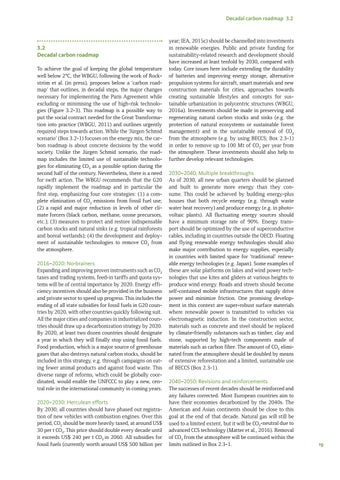Decadal carbon roadmap 3.2
3.2 Decadal carbon roadmap To achieve the goal of keeping the global temperature well below 2°C, the WBGU, following the work of Rockström et al. (in press), proposes below a ‘carbon roadmap’ that outlines, in decadal steps, the major changes necessary for implementing the Paris Agreement while excluding or minimising the use of high-risk technologies (Figure 3.2-3). This roadmap is a possible way to put the social contract needed for the Great Transformation into practice (WBGU, 2011) and outlines urgently required steps towards action. While the ‘Jürgen Schmid scenario’ (Box 3.2-1) focuses on the energy mix, the carbon roadmap is about concrete decisions by the world society. Unlike the Jürgen Schmid scenario, the roadmap includes the limited use of sustainable technologies for eliminating CO2 as a possible option during the second half of the century. Nevertheless, there is a need for swift action. The WBGU recommends that the G20 rapidly implement the roadmap and in particular the first step, emphasizing four core strategies: (1) a complete elimination of CO2 emissions from fossil fuel use; (2) a rapid and major reduction in levels of other climate forcers (black carbon, methane, ozone precursors, etc.); (3) measures to protect and restore indispensable carbon stocks and natural sinks (e.g. tropical rainforests and boreal wetlands); (4) the development and deployment of sustainable technologies to remove CO2 from the atmosphere.
2016–2020: No-brainers Expanding and improving proven instruments such as CO2 taxes and trading systems, feed-in tariffs and quota systems will be of central importance by 2020. Energy efficiency incentives should also be provided in the business and private sector to speed up progress. This includes the ending of all state subsidies for fossil fuels in G20 countries by 2020, with other countries quickly following suit. All the major cities and companies in industrialized countries should draw up a decarbonization strategy by 2020. By 2020, at least two dozen countries should designate a year in which they will finally stop using fossil fuels. Food production, which is a major source of greenhouse gases that also destroys natural carbon stocks, should be included in this strategy, e.g. through campaigns on eating fewer animal products and against food waste. This diverse range of reforms, which could be globally coordinated, would enable the UNFCCC to play a new, central role in the international community in coming years. 2020–2030: Herculean efforts By 2030, all countries should have phased out registration of new vehicles with combustion engines. Over this period, CO2 should be more heavily taxed, at around US$ 30 per t CO2. This price should double every decade until it exceeds US$ 240 per t CO2 in 2060. All subsidies for fossil fuels (currently worth around US$ 500 billion per
year; IEA, 2015c) should be channelled into investments in renewable energies. Public and private funding for sustainability-related research and development should have increased at least tenfold by 2030, compared with today. Core issues here include extending the durability of batteries and improving energy storage, alternative propulsion systems for aircraft, smart materials and new construction materials for cities, approaches towards creating sustainable lifestyles and concepts for sustainable urbanization in polycentric structures (WBGU, 2016a). Investments should be made in preserving and regenerating natural carbon stocks and sinks (e.g. the protection of natural ecosystems or sustainable forest management) and in the sustainable removal of CO2 from the atmosphere (e.g. by using BECCS; Box 2.3-1) in order to remove up to 100 Mt of CO2 per year from the atmosphere. These investments should also help to further develop relevant technologies.
2030–2040: Multiple breakthroughs As of 2030, all new urban quarters should be planned and built to generate more energy than they consume. This could be achieved by building energy-plus houses that both recycle energy (e.g. through waste water heat recovery) and produce energy (e.g. in photo voltaic plants). All fluctuating energy sources should have a minimum storage rate of 90%. Energy transport should be optimized by the use of superconductive cables, including in countries outside the OECD. Floating and flying renewable energy technologies should also make major contribution to energy supplies, especially in countries with limited space for ‘traditional’ renewable energy technologies (e.g. Japan). Some examples of these are solar platforms on lakes and wind power technologies that use kites and gliders at various heights to produce wind energy. Roads and streets should become self-contained mobile infrastructures that supply drive power and minimize friction. One promising development in this context are super-robust surface materials where renewable power is transmitted to vehicles via electromagnetic induction. In the construction sector, materials such as concrete and steel should be replaced by climate-friendly substances such as timber, clay and stone, supported by high-tech components made of materials such as carbon fibre. The amount of CO2 eliminated from the atmosphere should be doubled by means of extensive reforestation and a limited, sustainable use of BECCS (Box 2.3-1). 2040–2050: Revisions and reinforcements The successes of recent decades should be reinforced and any failures corrected. Most European countries aim to have their economies decarbonized by the 2040s. The American and Asian continents should be close to this goal at the end of that decade. Natural gas will still be used to a limited extent, but it will be CO2-neutral due to advanced CCS technology (Matter et al., 2016). Removal of CO2 from the atmosphere will be continued within the limits outlined in Box 2.3-1.
19
